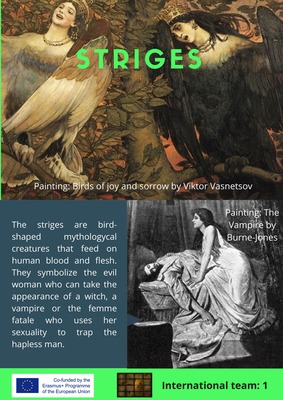Teacher in charge of managing this activity: Linda Alexopoulou
Skills that you are going to strengthen with this activity:
-Competence in artistic and cultural expressions: you will improve awareness of classical mythology and its influence in arts and literature.
-Linguistic competence: you will strength basic skills in English, classical languages, literature and arts. You will also develop imagination and creativity.
-Social and civic competence: The debate about accepting the female monsters will promote gender equality and inclusion. Furthermore, working in international teams will improve your multicultural and multilingual competence.
-Digital competence: Search for and process information critically and sistematically. Collaboratively create and share digital content.
-Sense of initiative and entrepreneurial spirit: You will develop initiative, proactivity and innovation.You are going to create content.
-Learning to learn competence: you will be able to pursue and persist in learning, to organize your own learning, including through effective management of time and information, both individually and in groups through cooperative work and interdisciplinary methodology.
Assessment rubric

As it appears in the paper El imaginario de la ambigüedad. Monstruos femeninos en el mundo antiguo by M.J. Marín, A. Martínez, A. Santiago of Barcelona University, "Ancient civilizations have served always of mythology to transmit its values and moral limits with a pedagogical purpose, thus establishing the role that each individual had to perform within the community." "In this way, the classical myths constitute basic socialization tools in relation to gender, since its transcendent nature and, therefore, its unquestioableness fix in the collective imagination the role that men and women should play."
On the other hand, Teresa M. Mayor says in the paper Monstruos femeninos en la mitología griega that: "Male misunderstanding of women and their misogyny are portrayed in each and every female mythological monster.They are monsters that embody the misgivings and irrational fear that many men felt towards women and their mystery."
Do you dare to investigate what the female monsters of classical mythology symbolize?
Monstresses and Monstrosities (Paleothea)
Female monsters in Literature (Wikipedia)

In this activity, after discusings about the simbolysm of the female monsters of the classical mythology, we are going to collaborativelly create 12 posters for the Female Monster Museum from works of art (paintings, sculptures, comics, mosaics, ceramics ...)
International teams.
Each poster shall include:
-The name of the monster.
-The title of the artwork or artworks that appear on the poster.
-The name of the authors of the artworks that appear on the poster.
-Some written and oral annotations in English explaining the symbolism of the female monster.
-The number of the transnational group.
-The logo of the project and the European Union.
Here you have an example:


Canva is a digital tool that will allow you to make collaborative posters with your group mates.
Here you have some simple tutorials to make presentations with Canva and Emaze:
